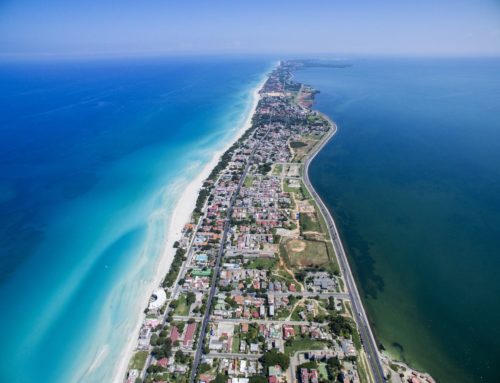Ecosystems
Ecosystems are classical examples of complex adaptive systems composed of many interacting elements acting and reacting to each other’s behavior
An ecosystem can be defined as a physical system composed of a set of biotic and abiotic elements that are interdependent in affecting each other and the overall state of the system.1 Ecosystems are governed by the laws of thermodynamics through which they can be described in terms of the interaction between energy, matter, and information. Within any given ecosystem energy is being processed through the system, each stage of that process involves the construction and deconstruction of matter into various structures, what is called the charge-discharge cycle, as energy is processed across some gradient through a network of biotic and abiotic elements.2 Elements within ecosystems can self-organization, where given enough input of free energy the system will endogenously self-organize to maximize the energy fluxes through the network as creatures co-evolve and co-adapt to occupy the various niches required.3 Ecosystems are dynamics entities subject to continuous micro and macro change processes while trying to maintain homeostasis as a product of feedback loops. Ecosystems are delineated by some boundary conditions which is a universal feature of biological systems.
Ecosystem Model
An ecology is before anything else a physical system, that is to say on its most fundamental level we are dealing with the interaction of energy and matter. Energy is being processed through the system, and each stage of that process involves the construction and deconstruction of matter into various structures as the resources are processed across some potential energy gradient. Energy is being inputted to the system via the sun, geothermal energy or gravity, and these are driving some process within earth’s systems. That process takes place from some high potential energy source to some lower potential energy sink. On an abiotic level, the ocean conveyor belt is driven by an energy gradient between the warm equator and the cold poles.4 The atmospheric winds are driven by an energy gradient between warm and cool geographical locations. On a global scale, the sunlight energy that reaches the Earth is eventually converted to low-level heat, leaving the Earth as radiation. On a biotic level, all biological creatures are driven by the energy gradient between the resources they consume and the entropy they export. Within biological creatures, we can call this process metabolism, as it takes place on every level from the metabolic pathways in a single cell to that of an organism to whole networks of creatures that form part of macro-level metabolic networks processing energy and resources through the whole ecosystem. Here the word metabolism is being used to refer to the capacity of a biological entity to harness and process free energy.
Sinks and Sources
All creatures have to intercept and process resources, and in doing this, creatures serve the overall function of processing energy through the system along the food web, they form a network of nodes processing the system’s input to its output. This process can be understood in terms of what are called sources and sinks. A general definition of the source and sink concept is based on net flows between the components of a system: a source is a subsystem or element that is a net exporter of some resource and a sink is a net importer of these resources. This flow of energy through an ecosystem is also referred to as the calorific flow.5 Through anabolic and catabolic processes, what is called the charge-discharge cycle, energy is processed through the network. Anabolism, which is the charge phase, is the incorporation of high-quality energy into biochemical structures, which keeps the system far from thermodynamic equilibrium. Catabolism is the discharge phase corresponding to the deterioration of the structure with the release of accumulated chemical energy and its transformation into work and heat. The classical example of this charge and discharge cycle being the relationship between autotrophs and primary consumers. Where the plants capture and fix energy into carbohydrates, before this is discharged in consumption by the animal. In so doing they complete an anabolic-catabolic cycle and transfer energy from high potential photons across a gradient to a lower potential, dispersed heat energy.
Energy Pyramid
Relationships between soil food web, plants, organic matter, birds and mammals within a metabolic network
An example of a full energy flow in an ecosystem would begin with the autotrophs that take energy from the sun. Herbivores then feed on the autotrophs and change the energy from the plant into energy that they can use. Carnivores subsequently feed on the herbivores and, finally, other carnivores prey on the carnivores. In each case, energy is passed on from one trophic level to the next trophic level and each time some energy is lost as heat into the environment.
This is due to the fact that each organism must use some energy that they received from other organisms in order to survive. The flow of resources through the metabolic network defines what is called the energy pyramid. The efficiency with which energy or biomass is transferred from one trophic level to the next is called the ecological efficiency. The percentage of energy at one step of a food chain that is available for consumption by the next step is called food chain efficiency. It is calculated as the energy in the food minus the energy used for respiration. It is typically 10 percent to 50 percent.6
Self-Organization
In this process of energy being transformed through the system from input to output, the system becomes an ecological network of components that have to fit together in some way, as they are interdependent in processing the inputted resources.7 From the different cells and organs in our body self-organizing around the collective functions required to process resources through the system to the self-organization of creatures within whole ecosystems as they co-adapt and co-evolve to perform differentiated niche roles with respect to each other. In every ecosystem abiotic and biotic plants, animals and microorganisms fit together functionally. Wherever it was thermodynamically feasible to transform matter a biological system has been created to do it.
This insight has been captured in the so-called maximum power principle (MPP) first proposed by Alfred Lotka.8 Which states that self-organizing systems, especially biological systems, capture and use available energy to develop network designs that maximize the energy fluxes through them which are compatible with the constraints of the environment and that those systems that maximize the throughput will endure. Thus, the MPP governs expediencies or efficiency in both the ecosystems functional and structural development. Theoretical and empirical research have supported the rationality of MPP including recent case studies that confirmed the development of subtropical forest plantations follow the MPP model.9
Constructal Law
Another way of understanding this is through the more general theory of what is called the construal law. Constructal law is a term recently coined by Adrian Bejan to describe the natural tendency of flow systems, such as rivers, trees, lungs, tectonic plates, to generate and evolve structures that increase flow access. It holds that shape and structure arise to facilitate flow. The designs that happen spontaneously in nature reflect this tendency: they allow entities to flow more easily – to measurably move more resources further and faster, per unit of useful energy.10
Energy-Matter Organization
The movement of materials in ecosystems is largely cyclic but the movement of energy is not cyclic. As it travels across the gradient it has the capacity to do work, to build and transform structures and those structures can become encoded into information. Through the input of energy, these elements are given some order or structure through which they can process resources, this structure can be defined in terms of the concept of information and entropy. Information can then be stored and replicated, allowing for a compounding, building upon itself, to become more complex over time through the process of evolution.
Environmental Gradient
A coastline represents a rapid change in an environmental gradient as it goes from a land to marine ecosystem
Like all complex systems, ecosystems are multilevel or multitiered systems that form some kind of hierarchy through the process of emergence. Shorter, faster biotic processes are nested within and dependent upon slower, longer abiotic processes.11 Meaning the biotic levels are largely defined by their geological conditions under which they have to operate. That is to say, the abiotic conditions largely define the outlining parameters to the biotic levels.
This structure to ecosystems, where the set of abiotic parameters shapes and defines the biotic elements within the system can be understood in terms of what is called the environmental gradient. An environmental gradient is a gradual change in abiotic factors through space or time. Environmental gradients can be related to factors such as altitude, temperature, depth, ocean proximity or soil humidity. Species abundances usually change along environmental gradients in a more or less predictable way.12 However, the species abundance along an environmental gradient is not only determined by the abiotic factor but also by the changes in the biotic interactions.
System’s Boundaries
These parameters within which an organism or ecosystem can function may be understood as its boundary condition. All organisms and ecosystems have some kind of boundary condition. The system’s boundary demarcates a limit to its internal components and processes. On a theoretical level, a boundary can be understood as the mechanism for regulating the input and output of energy and entropy and through this the maintenance of the system’s integrity. Internal to its boundary the system has some degree of integrity, meaning the parts are in some way operating cooperatively, working together, and this integrity gives the system a degree of autonomy. For example, if we take a tree, every part of the tree has been designed in some way to function as part of the entire system. The bark, leaves, and truck all serve some function with respect to the whole and thus they are integrated and through this integration, they are able to function independently from other systems in their environment. Thus the leaves in a tree are dependent upon the tree’s trunk and all the other elements to that tree but they are independent of the leaves and trunks of other trees, that is to say, the tree as an entirety has a degree of autonomy.
A system’s boundary is then demarcated by where the nexus of relations that enable it to function as a semi-integrated and autonomous whole reach their limit. Beyond this, the system loses its autonomy and has to interact with other systems and its environment. In the real world, all living organisms have boundaries. They are protected by a skin, a cuticle, a shell, or at least a resistant membrane that delineates them.13 Within ecosystems, this boundary may be termed the ecotone, which is a transition area between two biomes, where two communities meet and interact. An ecotone may appear on the ground as a gradual blending of the two communities across a broad area, or it may manifest itself as a sharp boundary line such as a cliff or sea-shore.14
Ecosystem Dynamics
Predator-prey dynamics are one example of a negative feedback loop that works to regulate the state of the ecosystem and maintain a stable state of development
Ecosystems are dynamic entities, they change over time due to various endogenous and exogenous factors such as abiotic disturbances like earthquakes or floods. At the same time that they are constantly changing they also have to maintain some form of stability to certain critical parameters, such as the PH level in a soil or temperature which are required for enabling organisms to function. This process whereby organisms or whole ecosystems regulate both change and continuity is called homeostasis and homeostasis is one of the defining features of life. The actual mechanisms through which this is done are called feedback loops.
On the micro-level of an individual organism these feedback loops may be controlled by a centralized regulatory system. But on the macro-level of a whole ecology, this regulation process is distributed out across many different feedback loops between many different species and geological factors. The counterbalancing process of negative feedback works to stabilize the system into a steady state of development. While positive feedback can work to drive nonlinear exponential growth or decay, creating ecological disturbances - such as hurricanes, climatic runaway effects, or population outbreaks. In this way, ecosystems can exhibit long-term stable development balanced by negative feedback, as seen during the process of succession, but also go through periods of rapid nonlinear growth and decay such as ecological collapse.15
Evolution
The long-term process of change within a biological population is understood through the theory of evolution. The theory of evolution is typically presented in an atomistic form as a narrative surrounding individualism, competition and the survival of the fittest. But within systems ecology, this process is understood in terms of the thermodynamics of the system’s metabolic network, within what is called the maximum eco-exergy principle.16 The elements of an ecosystem are organized as a network in which they fit together functionally. The community assembly process is able to select from a pool of species with the potential to fit together because species that have lived together in the same ecosystem for thousands of years have co-adapted to each other through biological evolution. As the community assembly process forms a food web, it selects only species that fit into the existing web. If the ecosystem receives more free energy than required to maintain their function, the surplus free energy will be applied to move the system further away from thermodynamic equilibrium.17 Ecosystems offer many possibilities to move away from thermodynamic equilibrium and they select the pathway that moves the ecosystem farthest from thermodynamic equilibrium, those pathways are enacted through different species or gene pools. The maximum eco-exergy principle states that ecosystems will develop towards higher levels of eco-exergy, where eco-exergy simply means the current stocks of available energy. In so doing they will move further away from thermodynamic equilibrium. Evolution can then be understood as a process of selection over a set of ecological elements that will best facilitate this process.18




























